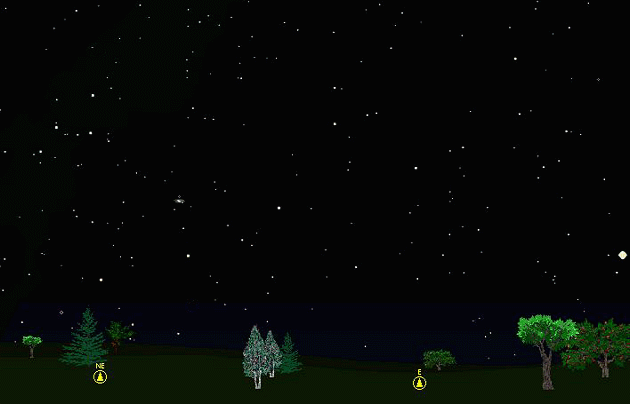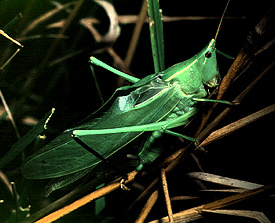|
The purpose of this feature is to give scout
leaders, educators and naturalists an idea of some of the natural events coming
up each month. We will try to cover a variety of natural events ranging
from sky events to calling periods of amphibians, bird and mammal watching
tips, prominent wildflowers and anything else that comes to mind. We
will also note prominent constellations appearing over the eastern horizon at
mid-evening each month for our area for those who would like to learn the
constellations. If you have suggestions for other types of natural
information you would like to see added to this calendar, let us know! Note: You can click on the hyperlinks to learn more about some of the featured items. To return to the Calendar, hit the "back" button on your browser, NOT the "back" button on the web page. Sky Events: Evening Sky: Bright Mars dominates the evening and morning sky this month. At midmonth it rises around 9:00pm, but for good telescopic views you need to look at it when it is due south and highest in the sky, around 2:15 am at midmonth. Otherwise, the atmospheric turbulence near the horizon will blur your views considerably. On August 27th, Earth approaches Mars to within 34,646,418 miles. This is the closest we've been to Mars in nearly 60,000 years! If you plan on observing Mars, use up to about 60 power per inch of aperture on your telescope, but if the image starts getting fuzzy on you, drop down to the next lower power that you have. A red filter helps bring out the dark areas, and it pays to be patient and wait for moments of better seeing, when the atmosphere momentarily becomes steadier and the image becomes sharper. These moments usually only last a short time. Try drawing the detail that you see (see last month's Natural Calendar). To make sure you're not imagining detail that's not really there, look to see if the detail rotates with the planet. Morning Sky: Both Venus and Jupiter are lost in the solar glare this month. Saturn rises around 3:00am at midmonth. The Perseid meteor shower peaks on the morning of August 13th. If you get up around 2:00am and look northeast you may see some members of this shower, which typically produces around 60 meteors per hour. The light from the nearly full moon will limit the number of meteors you will see this year.
All times noted in the Sky Events are for Franklin, Tennessee and are Central Daylight Time. These times should be pretty close anywhere in the mid-state area.
Constellations: The views below show the sky looking east at 9:30pm CDT on August 20th. The first view shows the sky with the constellation outlined and names depicted. Star and planet names are in yellow. Constellation names are in green. The second view shows the same scene without labels. New constellations this months are Pegasus, the Flying Horse, Andromeda, Princess Andromeda, Triangulum, the Triangle, Pisces, the Fishes, and Aquarius, the Water Bearer. Find the "Square of Pegasus" and work your way outward from it to the constellations around it. Look above beta Andromedae and see if you can pick out the faint glow of the Andromeda Galaxy, over 2 million light years away! City dwellers may need binoculars to pick it out. Simon Marius, in 1610, compared it's soft glow to "the light of a candle shining through horn." To get the best view, you may want to look for it when you get up in the early morning hours to look at Mars. It will be high overhead then, and if you look early in the month, there will be no moon to wash out the view. Mars dominates the southeastern part of the sky, blazing away like a hot coal in Aquarius.
On Learning the Constellations: We advise learning a few constellations each month, and then following them through the seasons. Once you associate a particular constellation coming over the eastern horizon at a certain time of year, you may start thinking about it like an old friend, looking forward to its arrival each season. The stars in the evening scene above, for instance, will always be in the same place relative to the horizon at the same time and date each August. Of course, the planets do move slowly through the constellations, but with practice you will learn to identify them from their appearance. In particular, learn the brightest stars for they will guide you to the fainter stars. Once you can locate the more prominent constellations, you can "branch out" to other constellations around them. It may take you a little while to get a sense of scale, to translate what you see on the computer screen or what you see on the page of a book to what you see in the sky. Look for patterns, like the stars that make up the "square of Pegasus." The earth's rotation causes the constellations to
appear to move across the sky just as the sun and the moon appear to do.
If you go outside earlier than the time shown on the charts, the constellations
will be lower to the eastern horizon. If you observe later, they will
have climbed higher. As each season progresses, the earth's motion around the sun
causes the constellations to appear a little farther towards the west each
night for any given time of night. If you want to see where the
constellations in the above figures will be on September 20th at 9:30pm CDT, you
can stay up till 11:30pm CDT on August 20th and get a preview. The westward
motion of the constellations is equivalent to two hours per month. A good book to learn the constellations is H. A. Rey's
classic, The Stars, A New Way to See Them. Rey's depictions of the
constellations and witty commentary are terrific. A good general reference book on astronomy is the Peterson
Field Guide, A Field Guide to the Stars and Planets, by Pasachoff.
The book retails for around $14.00. A good beginners software program for learning the night sky
is the Starry Night Beginner program. Visit the Starry Night web site at
www.starrynight.com The program retails for around $30.00 and
contains a wealth of information. Amphibians: Listen for Cope's Gray Treefrogs, Gray Treefrogs, Bird-Voiced Treefrogs, Green Treefrogs and Barking Treefrogs. Northern Cricket Frogs and Southern Cricket Frogs are still calling, as are Bullfrogs and Green Frogs. Spring Peepers have a much higher, shorter call this time of year. On cooler nights listen for American Toads. After heavy rains listen for the high, insect-like call of the Eastern Narrowmouth Toad and the strange-sounding Eastern Spadefoot.
Birds: Be sure to check around ponds, river banks and on exposed mud flats for shorebirds, as many of them pass through Tennessee in August and September in their fall migration. Recommended: The Sibley Guide to Birds, David Allen Sibley For the eastern United States only, A Field Guide to the Birds East of the Rockies, Roger Tory Peterson An inexpensive guide for beginners is the Golden Guide for Birds.
Insects:
Recommended: Songs of Crickets and Katydids of the Mid-Atlantic States, by Rannels, Hershberger and Dillon Archives (Remember to use the back button on your browser, NOT the
back button on the web page!)
Natural Calendar
February 2003
Natural Calendar
December 2002
Natural Calendar
November 2002
Nature Notes Archives:
Nature Notes was a page we published in 2001 and 2002 containing our
observations about everything from the northern lights display of November 2001
to frog and salamander egg masses. Night scenes prepared with Starry Night Pro software All photographs
Ó2003
LEAPS
|


 Last month we talked a little about the far ranging rasps of Coneheads. The Robust Conehead has a length up to 2-3/8
inches and has a very long-lasting rasp, whereas the Nebraska
Conehead has a rasp that lasts about 2 seconds. Both are common in
Tennessee in August. Shown is a photo of a Robust Conehead. Note
the yellow stripe down the side of the prothorax.
Last month we talked a little about the far ranging rasps of Coneheads. The Robust Conehead has a length up to 2-3/8
inches and has a very long-lasting rasp, whereas the Nebraska
Conehead has a rasp that lasts about 2 seconds. Both are common in
Tennessee in August. Shown is a photo of a Robust Conehead. Note
the yellow stripe down the side of the prothorax.